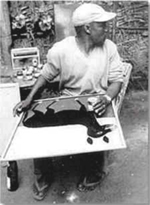 |
|||||||
|
______________________________________________________________________________________________________________________
|
|||||||
| HOME |
|
| ARTISTS
|
|
| CONTACT |
|
| NEWS
|
|
|
BIO | EXHIBITIONS | AVAILABLE WORK
E.S. TINGATINGA, 1932 - 1972
BIO Edward Saidi Tingatinga was the origin of the naive style of painting who would later take his name. Tingatinga started painting in 1968, and although his career was ended prematurely in 1972, his style inspired his five students and then his followers to establish the Tingatinga School of Painters that continues to florish today. In only three years, Edward Saidi Tingatinga had won a name for himself in Tanzanian art. Unlike most Tanzanian artists, who had specialized in ebony, E.S. Tingatinga was a painter. He has had no formal art training, nor had he attended any academy of art. His painting resulted simply from his desire to express himself through the media of hardboard, paint and brush. His work was straightforward; its message transmitted to everyone because he focused on those familiar things. Tingatinga (also seen, incorrectly as tinga-tinga) painted animals, birds, people, and a score of other things. He was born of peasant parents in 1932 in the remote village of Mindu, in southern Tanzania's Tunduru District on the Mozambique border. He received a rudimentary education during two years spent attending the local school. The rest of his early years were spent in the manner of most peasant boys: helping in the general duties of the home, learning various crafts, and most importantly, cultivating the land which is the major means of subsistence.
Tanzania's independence brought in painters, mainly from Zaire (formerly Republic of the Congo) who produced inexpensive pictures for sale along the city's main streets. This new turn of events sparked Tingatinga 's former urge to paint; he managed to obtain some household paint and a brush from a friend, located a piece of crude ceiling board and created his first picture. He displayed it outside the Morogoro Stores in Dar es Salaam, where it eventually fetched him some 10 shillings! That was the beginning of his new career. He bought more material and concentrated on painting as much as possible. Artist friends advised him on supplies, and he soon changed from household paint to a better type. Subsequently, Tingatinga found a permanent job with the Ministry of Health and Social Welfare at Muhimbili Hospital where he worked as a nursing assistant while devoting as much time as possible to his art. When Tingatinga was not at the hospital, he could be found painting at his home, a room in one of the poorer houses in Msasani, a Dar es Salaam suburb, where he lives with his wife and two children. Just before he died, the National Arts Council, a subsidiary of the National Development Corporation, decided to exhibit his works in their display rooms in the city center and again later in their pavillion at the 1971 Saba Saba International Trade Fair. This helped him greatly as he gained a contract with the National Arts Council, who provided him with material and handled the sale of his paintings. Tingatinga feelt that he was far from being a polished artist. Although, his works were still somewhat artistically crude, he nonetheless said, "All the same they are good; this is why people buy them. They must somehow be meaningful." Recently Tingatinga 's paintings have become widely known and increasingly in demand.
source:
"Tinga Tinga, the popular paintings fom Tanzania", Y.
Goscinny; J.A.R. Wembah-Rashid in African Arts, 1972
RELATED: [other influential artists of the Tingatinga movement] |
||
|
LINKS
|
|
about
us
| africa
today | artists
| contacts
| painting
|photography
| sculpture
african contemporary - contemporary african art gallery (c) 2017 > All rights reserved | privacy policy |
 In
1955 E.S. Tingatinga decided to try his luck and travelled to
Dar es Salaam to look for a job. He managed to find work as a
domestic servant in a colonial civil servant's home, where he
remained until 1961 when Tanzanian Independence arrived and his
employer left. During those six years Tingatinga had occasion
to watch the work of the government painters who periodically
came to paint the government house in which he stayed; each time
he marvelled at the ceiling boards, the bright colors and the
graceful brush strokes of the painters. He longed to try his hand
at the job, but his regular duties left no time for it. When his
job ended in 1961 he became desperate. He found work here and
there, but it was never permanent, and his life became increasingly
difficult.
In
1955 E.S. Tingatinga decided to try his luck and travelled to
Dar es Salaam to look for a job. He managed to find work as a
domestic servant in a colonial civil servant's home, where he
remained until 1961 when Tanzanian Independence arrived and his
employer left. During those six years Tingatinga had occasion
to watch the work of the government painters who periodically
came to paint the government house in which he stayed; each time
he marvelled at the ceiling boards, the bright colors and the
graceful brush strokes of the painters. He longed to try his hand
at the job, but his regular duties left no time for it. When his
job ended in 1961 he became desperate. He found work here and
there, but it was never permanent, and his life became increasingly
difficult.